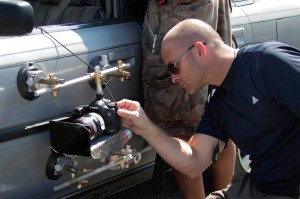
A director of photography for the past two decades, David Klein, ASC, has shot movies and television shows using numerous film and digital formats. “Every motion-picture film stock has its own look,” he noted, “and that’s true of every digital cinema camera as well.” A firm believer that the needs of the production should always dictate its capture medium, Klein shot the 2011 feature Red State using a combination of digital camera systems, including EOS 7D Digital SLR cameras from Canon U.S.A. More recently he tested the Canon EOS C300 Digital cinema camera. Both models prompted him to comment, “I’m happy that Canon is in the motion picture business.”
“I have been a Canon shooter my entire life,” Klein recalled. “I shot one of my first student films on a Canon Scoopic, which was a great 16mm camera. I used mostly film for the first part of my career, but have been half film/half digital for the past eight years or so.”
To shoot Red State Klein chose the Canon EOS 7D Digital SLR for hand-held “run-and-gun” style shots that were essential to the film. The 7D Digital SLR camera is equipped with an 18.0 Megapixel APS-C size CMOS sensor and dual DIGIC 4 image processors that enable it to record 1920 x 1080 HD images at the user-selectable frame rate of 24P (23.976 fps), the standard for theatrical filmmaking.
“It seemed while shooting that the Canon EOS 7D was the best way to get a lot of the shots we needed,” he noted. “It’s a small camera, but it delivers high-quality cinematic images. We used a remote-focus unit with it, and put its controller and batteries in a backpack. That way, the only thing in my hand was a pistol grip holding the EOS 7D camera, its lens and the remote-focus motor. Many highly portable digital cameras have come out since the EOS 7D camera, but I still think it’s the only way that some of those shots could have been attained. The look we got from the EOS 7D camera, mixed with images from a larger digital cinema camera, was perfect for that movie.”
Klein, who is currently shooting a film-originated TV series, is interested in using the C300 digital cinema camera, which he has tested, and its 4K counterpart, the C500. “I know that those cameras are right for some project in the near future for me,” he said. “They are very user-friendly with great ergonomic design. You put them in your hands and you go. They’re a lot like a digital SLR camera. They also make great images and are super-sensitive in terms of their low-light abilities.”
The C500 camera is capable of originating 4K (4096 x 2160) images with uncompressed RAW output for external recording. The C300 camera delivers 1920 x 1080 HD images for a wide range of cinematography applications, including movies, episodic TV series and commercials.
Both cameras employ Canon’s single Super 35mm 8.85 Megapixel CMOS sensor and Canon’s DIGIC DV III image processor and both are also available in EF or PL lens-mount versions.





